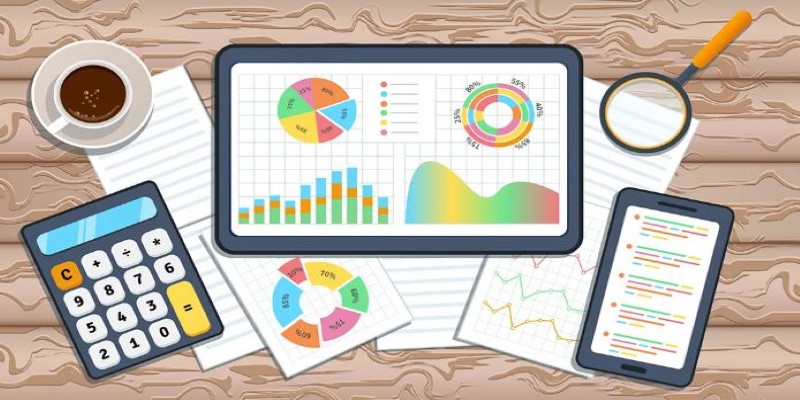The Ultimate Guide to IRS Publication 17 and Filing Your Taxes Correctly
Dec 11, 2024 By Pamela Andrew
Filing taxes can feel daunting, especially with the intricacies of U.S. tax law. Fortunately, IRS Publication 17 is here to simplify things. This annual guide by the IRS is designed to help individuals understand the essentials of filing, from reporting income and claiming deductions to ensuring compliance with federal tax laws.

Whether you are filing for the very first time or need a refresher, Publication 17 has plain words to help you complete your return accurately and confidently. In this post, we will discuss what the IRS has in its Publication 17, how it works, and why it is an invaluable resource for taxpayers.
What is IRS Publication 17?
IRS Publication 17, commonly known as "Your Federal Income Tax," is a yearly guide provided by the IRS that assists individuals in preparing their returns, especially first-time filers or even less complex filers. The IRS publishes new editions of this guide every year to reflect changes in tax law. This guide provides the requirements for basic filing, income reporting, credits, deductions, and maintaining records.
Organized to gradually build understanding, the guide moves from foundational filing steps to more specific tax situations, such as capital gains and various credits. Its purpose is rather clear: to help taxpayers understand their responsibilities and avoid common mistakes so the filing process is smoother, more accurate, and less stressful.
How Does IRS Publication 17 Work?
At its core, IRS Publication 17 is an instruction book designed to make the process of filling in tax forms as easy as possible. The IRS releases the book each year in print and electronic format. Here's how to do it:
Accessible Format and Clear Language
One of the most helpful aspects of IRS Publication 17 is its clear language and organized layout. Although taxes can involve complex language, the IRS has made an effort to make this publication accessible, using plain language whenever possible. Each section follows a logical progression, making it easier for readers to follow along.
Comprehensive Coverage of Tax Topics

Publication 17 is organized into chapters covering the essential aspects of tax filing. These chapters include information on who must file, types of income that must be reported, allowable deductions and credits, and more. Each chapter delves into common taxpayer questions and situations, providing detailed explanations and real-life examples where relevant.
Helpful Examples and Situational Advice
Publication 17 includes a range of examples that illustrate common tax situations to help taxpayers understand specific scenarios. These examples clarify how different income types, credits, and deductions apply in various contexts, which is especially useful for individuals with unique circumstances, like freelancers or part-time employees.
Guidance on Avoiding Common Errors
The IRS also uses Publication 17 to guide readers in avoiding frequent tax filing errors. This includes tips on double-checking Social Security numbers, correctly claiming dependents, and accurately reporting income. By following this advice, taxpayers can reduce the chance of errors, which often leads to faster processing and fewer delays.
Key Sections in IRS Publication 17
IRS Publication 17 covers a lot of ground, so understanding its main sections can make it easier to navigate. Heres a look at some of the key areas it addresses:
Filing Requirements and Procedures
This section outlines who must file a tax return based on age, income type, and filing status. Publication 17 explains income thresholds and provides step-by-step guidance for taxpayers with varied income situations to complete essential forms like Form 1040.
Income and Adjustments
Publication 17 explains different income types, including wages, freelance earnings, rental income, and investments, helping taxpayers report them accurately. It also covers adjustments like retirement contributions and student loan interest, which can reduce taxable income and potentially lower total tax owed.
Deductions and Credits

The publication details deductions that reduce taxable income, such as medical expenses, and tax credits like the Earned Income Tax Credit (EITC) and Child Tax Credit, which directly reduce taxes owed. Examples clarify how these benefits apply in various tax scenarios.
Tax Payment and Refund Options
After calculating taxes, taxpayers can choose payment or refund options. Publication 17 explains methods like electronic withdrawal and installment plans and highlights direct deposit as a faster refund option, helping taxpayers make informed choices about paying or receiving refunds.
Record-Keeping and Documentation
IRS Publication 17 emphasizes the importance of organized record-keeping. It advises taxpayers on which documents to retain, including receipts for deductions, copies of returns, and records for donations. It offers tips on staying prepared in case of an audit or filing questions.
Why is IRS Publication 17 Useful for Taxpayers?
IRS Publication 17 stands out as a valuable tool because it provides not just rules but context and clarity. Many taxpayers find it useful because:
It Simplifies Complex Information: Tax laws are complex, and Publication 17 simplifies them into simpler language, making them more accessible to those unfamiliar with tax terminology.
It Encourages Accuracy: Addressing common errors and explaining tax forms in detail helps taxpayers avoid mistakes that could lead to penalties or delays in refunds.
Its a Free Resource: Unlike paid tax-preparation software, Publication 17 is free and available to anyone, either online or in print, making it an affordable way to ensure tax accuracy.
It Builds Confidence in Tax Filing: For individuals who choose to file on their own, having IRS Publication 17 as a guide can boost confidence, especially for those with straightforward tax situations who may not need to hire a tax professional.
Conclusion
IRS Publication 17 remains an invaluable resource for taxpayers, simplifying the process of understanding and meeting tax obligations. Whether you're new to filing or simply want to brush up on the essentials, this publication is designed to support taxpayers through clear guidance, helpful examples, and up-to-date tax law information. By familiarizing yourself with its contents, you can not only make tax season less stressful but also ensure you're taking advantage of all available credits and deductions. For anyone looking to save time, avoid errors, and file confidently, IRS Publication 17 is truly a must-read.








